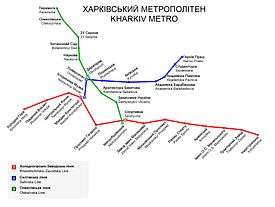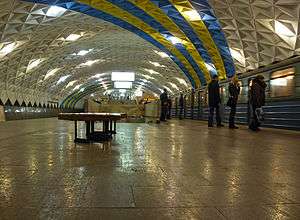Kholodnohirsko–Zavodska Line
 | |||||||||||||||||||||||||||||||||||||||||||||||||||||||||||||||||||||||||||||||||||||||||||||||||||||||||||||||||||||||||||||||||||||||||||||||||||||||||||||
| Overview | |||||||||||||||||||||||||||||||||||||||||||||||||||||||||||||||||||||||||||||||||||||||||||||||||||||||||||||||||||||||||||||||||||||||||||||||||||||||||||||
| Type | Rapid transit | ||||||||||||||||||||||||||||||||||||||||||||||||||||||||||||||||||||||||||||||||||||||||||||||||||||||||||||||||||||||||||||||||||||||||||||||||||||||||||||
| System | Kharkiv Metro | ||||||||||||||||||||||||||||||||||||||||||||||||||||||||||||||||||||||||||||||||||||||||||||||||||||||||||||||||||||||||||||||||||||||||||||||||||||||||||||
| Status | Operational | ||||||||||||||||||||||||||||||||||||||||||||||||||||||||||||||||||||||||||||||||||||||||||||||||||||||||||||||||||||||||||||||||||||||||||||||||||||||||||||
| Termini |
Kholodna Hora (western) Industrialna (eastern) | ||||||||||||||||||||||||||||||||||||||||||||||||||||||||||||||||||||||||||||||||||||||||||||||||||||||||||||||||||||||||||||||||||||||||||||||||||||||||||||
| Stations | 13 | ||||||||||||||||||||||||||||||||||||||||||||||||||||||||||||||||||||||||||||||||||||||||||||||||||||||||||||||||||||||||||||||||||||||||||||||||||||||||||||
| Daily ridership | 545,070 (daily)[1] | ||||||||||||||||||||||||||||||||||||||||||||||||||||||||||||||||||||||||||||||||||||||||||||||||||||||||||||||||||||||||||||||||||||||||||||||||||||||||||||
| Operation | |||||||||||||||||||||||||||||||||||||||||||||||||||||||||||||||||||||||||||||||||||||||||||||||||||||||||||||||||||||||||||||||||||||||||||||||||||||||||||||
| Opened | August 23, 1975 | ||||||||||||||||||||||||||||||||||||||||||||||||||||||||||||||||||||||||||||||||||||||||||||||||||||||||||||||||||||||||||||||||||||||||||||||||||||||||||||
| Operator(s) | Kharkivskyi metropoliten | ||||||||||||||||||||||||||||||||||||||||||||||||||||||||||||||||||||||||||||||||||||||||||||||||||||||||||||||||||||||||||||||||||||||||||||||||||||||||||||
| Rolling stock | 81-717/714, Еж3, Ем508т | ||||||||||||||||||||||||||||||||||||||||||||||||||||||||||||||||||||||||||||||||||||||||||||||||||||||||||||||||||||||||||||||||||||||||||||||||||||||||||||
| Technical | |||||||||||||||||||||||||||||||||||||||||||||||||||||||||||||||||||||||||||||||||||||||||||||||||||||||||||||||||||||||||||||||||||||||||||||||||||||||||||||
| Line length | 17.3 kilometres (10.7 mi)[2] | ||||||||||||||||||||||||||||||||||||||||||||||||||||||||||||||||||||||||||||||||||||||||||||||||||||||||||||||||||||||||||||||||||||||||||||||||||||||||||||
| Track gauge | 5 ft (1,524 mm) | ||||||||||||||||||||||||||||||||||||||||||||||||||||||||||||||||||||||||||||||||||||||||||||||||||||||||||||||||||||||||||||||||||||||||||||||||||||||||||||
| |||||||||||||||||||||||||||||||||||||||||||||||||||||||||||||||||||||||||||||||||||||||||||||||||||||||||||||||||||||||||||||||||||||||||||||||||||||||||||||
The Kholodnohirsko–Zavodska Line (Ukrainian: Холодногірсько-Заводська лінія, Russian: Холодногорско-Заводская линия) is a line of the Kharkiv Metro, serving Kharkiv, the second largest city in Ukraine. The line is the first segment of the Kharkiv Metro system, in operation since 1975. It is longest of the system's three metro lines at 17.3 kilometres (10.7 mi)[2] and has the most number of stations (at 13), compared to the other two lines' eight station segments.
Geographically, the Kholodnohirsko–Zavodska Line cuts Kharkiv on an east-west axis, providing subway access for the industrial districts lining the Moskovskyi Prospect with the city center. Since it is an important transport thoroughfare of both the metro and the city as a whole, the Kholodnohirsko–Zavodska Line has the highest passenger traffic of the three lines, having a daily ridership of 545,070 passengers.[1]
History
Construction of a metro system in Kharkiv became evident in 1967, when the Soviet Council of Ministers approved the construction of the system's first line, then referred to as the Sverdlovsko–Zavodska Line (Ukrainian: Свердловсько-Заводська лінія).[3] Subsequently, construction on the line began on July 15, 1968 near where the Pivdennyi Vokzal station is located. On August 23, 1968, a date symbolic of the 25th anniversary of the liberation of Kharkiv from Nazi German occupation, tunnel construction began near the Radianska station (now Maidan Konstytutsii station).[2][4][5]
The first segment of the Kharkiv Metro system was built in relatively difficult hydrogeological situations.[2] Specifically, engineers had to construct the line under two local rivers, the Kharkiv and the Lopan, and under two high traffic rail road stations, Kharkiv-Passenger and Kharkiv-Balashovskyi, respectively. Despite these difficulties, the first segment of the Kholodnohirsko–Zavodska Line was finished relatively quickly, and was ready for its grand opening on August 23, 1975.[2] The Kholodnohirsko–Zavodska line would be extended just three years later to encompass a total of 13 stations and 17.3 kilometres (10.7 mi) of running track.
Heavy rainfall in the summer of 1996 contributed to the flooding of one of the system's first stations, the Tsentralnyi Rynok.[6] During the reconstruction efforts, central vertical columns were added, creating a unique mix of single-vault rounded ceiling supported by numerous columns, which would otherwise be self-supportive. During its reconstruction, which lasted about a year, the station was fully operational and open to the public.
Timeline
| Segment | Date opened | Stations | Length[nb 1] |
|---|---|---|---|
| "Moskovske" Depot | July 30, 1975[2] | - | - |
| Kholodna Hora—Moskovskyi Prospekt | August 23, 1975[2] | 8 | 9.8 km |
| Palats Sportu—Industrialna | August 11, 1978[2] | 5 | 7.5 km |
| Total: | 13 stations | 17.3 km[2] | |
Name changes
Following the fall of the Soviet Union in 1991 and the subsequent Ukrainian independence, some of the stations were renamed to more neutral equivalents, sometimes avoiding reference to significant Soviet institutions and their leaders. In addition to the renaming of the line to its current title with the subsequent name change at the Kholodna Hora station,[2] two other stations were renamed, the last of which occurred in 2004.
- Komsomolska (1978–1994) → Marshala Zhukova (1994–2016) →Palats Sportu
- Vulytsia Sverdlova (1975–1995) → Kholodna Hora, named for the city's Kholodna Hora residential neighborhood.
- Industrialna (1978–2004) → Imeni O.S. Maselskoho, named after the Soviet Ukrainian politician Oleksandr Maselskyi.
On 20 November 2015 the station Radianska was renamed Maidan Konstytutsii to comply with decommunization laws[5][4]
Stations


Most of the stations on the line were constructed shallow near the surface, with exception to the Pivdennyi Vokzal and Ploshcha Konstytutsii stations which were constructed deep underground due to the different elevations and hydrogeological conditions in those areas. Six of the shallow stations consist of a central platform and vaulted ceiling supported by five columns; the other five shallow stations have a single vaulted ceiling with no columns (with exception to Tsentralnyi Rynok). The two deep stations are both pylon stations, in which the central hall is separated by arcades leading to the station platforms.
Transfers
Traditional Soviet metro planning stipulated the creation of the first line (almost always a system's Red Line), which would at some point in the future be expanded and crossed by future planned lines. The Kharkiv Metro is no exception to this traditional planning scheme; the Kholodnohirsko–Zavodska Line was built with the future expansion in mind. Currently, the two transfer stations from the Saltivska Line (Blue Line) and the Oleksiivska Line (Green Line) are both terminus stations, although a perspective extension would add two subsequent stations to both line segments. Specifically, the Kholodnohirsko–Zavodska Line has two transfer stations:
| # | Transfer to | At | Opened |
|---|---|---|---|
| Istorychnyi Muzei (Saltivska Line) | Maidan Konstytutsii | August 10, 1984 | |
| Metrobudivnykiv (Oleksiivska Line) | Sportyvna | May 6, 1995 |
Technical specifications
Just like with the Kiev Metro, government planning agencies allowed for a maximum of five carriage trains that would fit on the 100 metres (330 ft) station platforms without any modification to the station structure.[7] Specifically, 25 five-carriage trains are assigned to serve the Kholodnohirsko–Zavodska Line, serviced from the Depot-1 "Moskovske", located between the Moskovskyi Prospekt and Marshala Zhukova stations.[2]
Interestingly, the Kholodnohirsko–Zavodska Line was the first metro line in the Soviet Union (and the Kharkiv Metro) to use a unified central time system (Russian: ЦЭЧС-75), produced by the Khronotron factory in former city of Leningrad in modern-day Russia. Before the introduction of this system, all of the stations of the system used an analog clock system, where in the intervals in between train arrivals a full rotation of the clock hand amounted to five minutes.[2]
Future extension
New construction work on the Kholodnohirsko–Zavodska Line has not been conducted since the latest five station extension eastwards from the Moskovskyi Prospekt station to the current terminus at Industrialna. However, two future extensions to the line are planned: Zalutyno station westwards from the terminus at Kholodna Hora and Vostochna and Rohanska stations eastwards from the Industrialna station.[2] These extensions are currently only perspective extensions and have been proposed continually since the late 1980s when those areas of the town were being populated.[2]
Currently, the line serves its usefulness as the busiest line of the Kharkiv Metro system, connecting many industrial neighborhoods with the center of town. The Kholodnohirsko–Zavodska Line's expansion both westwards and eastwards would be in the long term perspective at least, considering that no official initiative to begin the construction at either ends was outlined in the "Oblast Program of Construction and the Expansion of the Kharkiv Metropoliten, 2007-2012."[8]
Notes
- ↑ Approximate length, includes only operational passenger track length, does not include service track length.
References
| Wikimedia Commons has media related to Kholodnohirsko-Zavodska Line. |
- 1 2 "Kholodnogorsko-zavodskaya liniya". Commercial holding "Megapolis" (in Russian). Retrieved 19 May 2011.
- 1 2 3 4 5 6 7 8 9 10 11 12 13 14 Butkovsky, Andrey (2008). "Metro. Kholodnogorsko-Zavodskaya Line". Kharkov transportny (in Russian). Retrieved 17 May 2011.
- ↑ "How everything began". Official site KP "Kharkivskyi metropoliten" (in Ukrainian). metro.kharkov.ua. Retrieved 17 May 2011.
- 1 2 (Russian) List of 170 renamed streets, SQ (20 November 2015)
- 1 2 (Ukrainian) List of renamed objects in Kharkiv, Official site of Kharkiv city council (20 November 2015)
- ↑ Butkovsky, Andrey (2010). "Stations and constructions. Station "Tsentralny rynok"". Kharkov transportny (in Russian). Retrieved 1 June 2011.
- ↑ Schwandl, Robert. "KHARKIV Metro (Kharkov)". UrbanRail.Net. Retrieved 17 May 2011.
- ↑ "Program of the construction of the metro". Official site of the KP "Kharkivskyi metropoliten" (in Ukrainian). metro.kharkov.ua. Retrieved 31 May 2011.